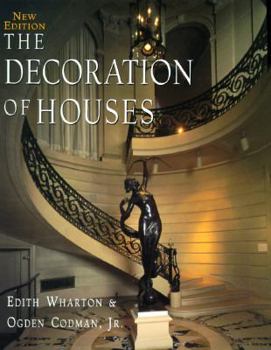The Decoration of Houses
Select Format
Select Condition 
Book Overview
Thousands of books on interior design have come and gone since the 1897 publication of this pioneering manual, but The Decoration of Houses remains, thanks to the insightful and inspiring advice of... This description may be from another edition of this product.
Format:Hardcover
Language:English
ISBN:0393038858
ISBN13:9780393038859
Release Date:January 1997
Publisher:W. W. Norton & Company
Length:294 Pages
Weight:1.74 lbs.
Dimensions:0.9" x 7.8" x 9.6"
Related Subjects
Architecture Arts, Music & Photography History Home & Garden House & Home Interior DesignCustomer Reviews
2 ratings
design reflection and illumination
Published by Thriftbooks.com User , 17 years ago
Amidst today's seemingly endless supply of domestic guides and treatises on interior decoration, Edith Wharton might be surprised that her The Decoration of Houses (co-authored with architect Ogden Codman, Jr.) would still be as relevant and necessary as it is a century after its first publication. Long before "simplicity" and "classic" became catchwords for branding, Wharton took a public stand against the bland, trite excesses of Victorian décor in America. Favoring the considered, informed and complex processes of design rooted in architectural principles, her graceful humility was matched only by her assertive plea against the contemporary dominance of thoughtless, conspicuous consumption visible in New York society. As she determinately decreed: "According to the creed of the modern manufacturer, you have only to combine certain `good' to obtain a certain style." Often associated with the frivolity connected to historical descriptions of femininity, this volume might be a surprise for those who prefer to view Wharton as a New York literary powerhouse. While her 40 books in 40 years (many of which were devoted to travels through European residences and gardens) are a testament to the force of her pen, it's the themes of beauty, pleasure, societal indulgence, cultural education and cosmopolitanism in America's modernity that make her analysis, and eventual ruling on the importance of design and space, a necessary extension of her literary thought. As she aptly begins her historical and aesthetic analysis, "Rooms may be decorated in two ways: by a superficial application of ornament totally dependent of structure, or by means of those architectural features which are part of the organism of every house, inside as well as out." And it's through these sixteen chapters that reflect on everything from the front door to the dining room to bric-a-brac that she offers readers a glimpse at the historic function of furnishings, as well as her claims about taste, beauty and the impact of residential design. The Italian, French and British capacity for decorating in accord with the Grecian edict of "wise moderation," so admired by Wharton, is illustrated by black and white plates. The illustrations also reveal that the author's penchant for "classic" beauty wasn't about recreating kitschy historic facades or stoic sparseness. Rather, a considered pleasure seems to be her goal as she concludes, "There is no absolute perfection, there is no communicable ideal; but much that is empiric, much that is confused and extravagant, will give way before the application of principles based on common sense and regulated by the laws of harmony and proportion." True to her appreciation for sincerity in the application of decorative principles, readers can see the realization of her rules if they visit the Mount, a 113-acre Lenox estate designed by Wharton in 1902. Recreated by Rizzoli using photographs of the original 1897 pressing, the only change made by the publis
Decoration of Houses as a gift, and as an owner
Published by Thriftbooks.com User , 18 years ago
The "Decoration of Houses" allows a comparison of styles from antique to modern, with variations for each time period. I own it, but gave it to my daughter too, since she does set design in New York. The only one tht is better, is one that is out of print. My father used as a decorator in Boston.






